Abstract
Phycobiliproteins, unlike other light-harvesting proteins involved in photosynthesis, bear covalently attached chromophores. The bilin chromophores are attached through thioether bonds to cysteine residues. The cyanobacterium Synechococcus sp. PCC 7002 has eight distinct bilin attachment sites on seven polypeptides, all of which carry the same chromophore, phycocyanobilin. When two genes in the phycocyanin operon of this organism, cpcE and cpcF, are inactivated by insertion, together or separately, the surprising result is elimination of correct bilin attachment at only one site, that on the alpha subunit of phycocyanin. We have overproduced CpcE and CpcF in Escherichia coli. In vitro, these proteins catalyze the attachment of phycocyanobilin to the alpha subunit of apophycocyanin at the appropriate site, alpha-Cys-84, to form the correct adduct. CpcE and CpcF also efficiently catalyze the reverse reaction, in which the bilin from holo-alpha subunit is transferred either to the apo-alpha subunit of the same C-phycocyanin or to the apo-alpha subunit of a heterologous C-phycocyanin. The forward and reverse reactions each require both CpcE and CpcF and are specific for the alpha-Cys-84 position. Phycocyanobilin is the immediate precursor of the protein-bound bilin.
Full text
PDF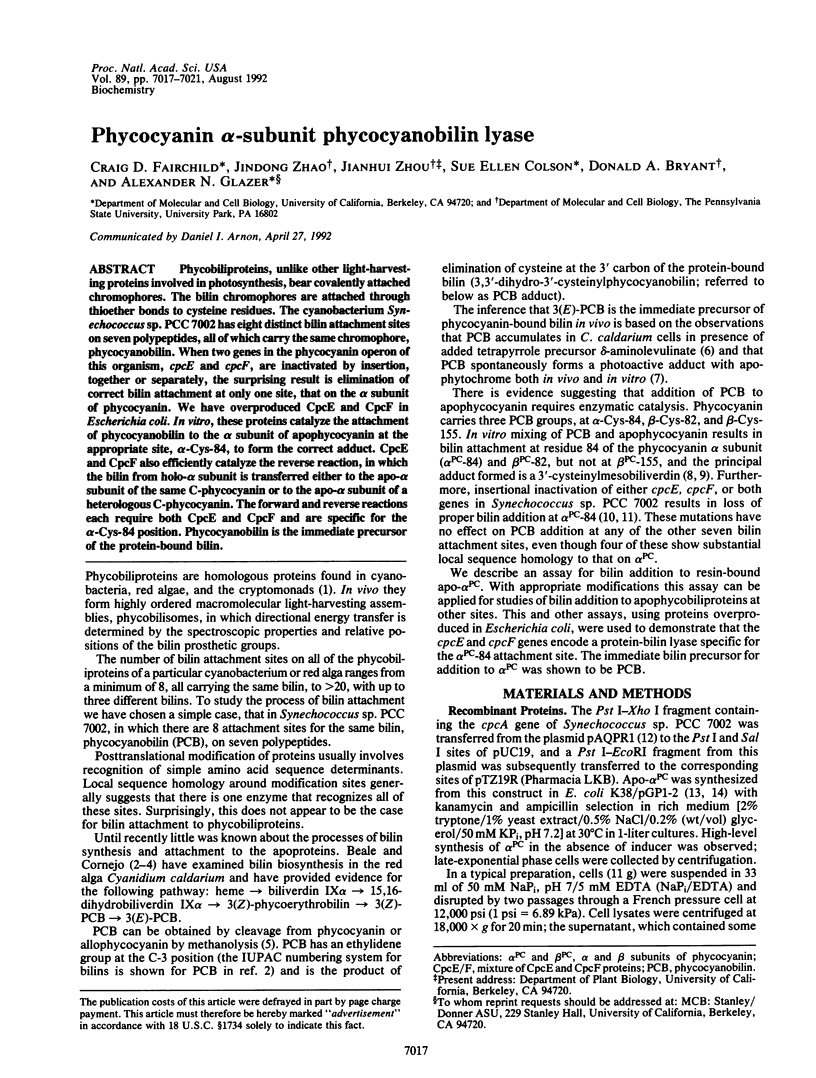
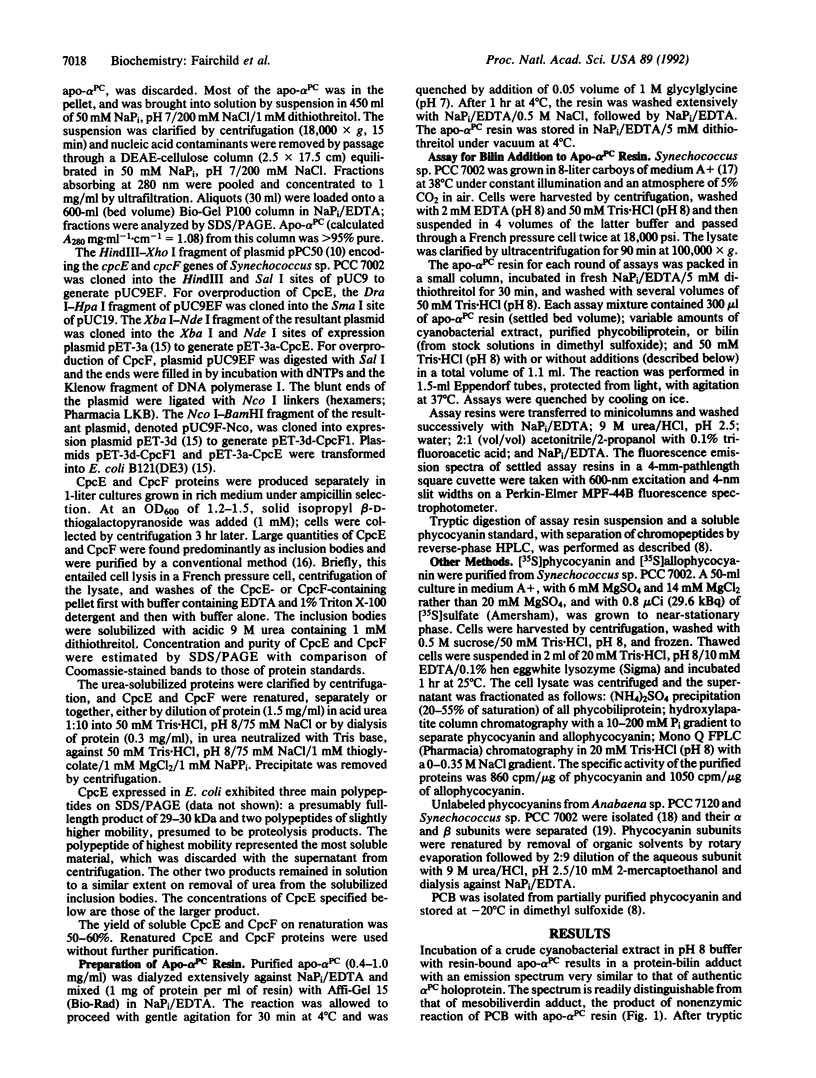
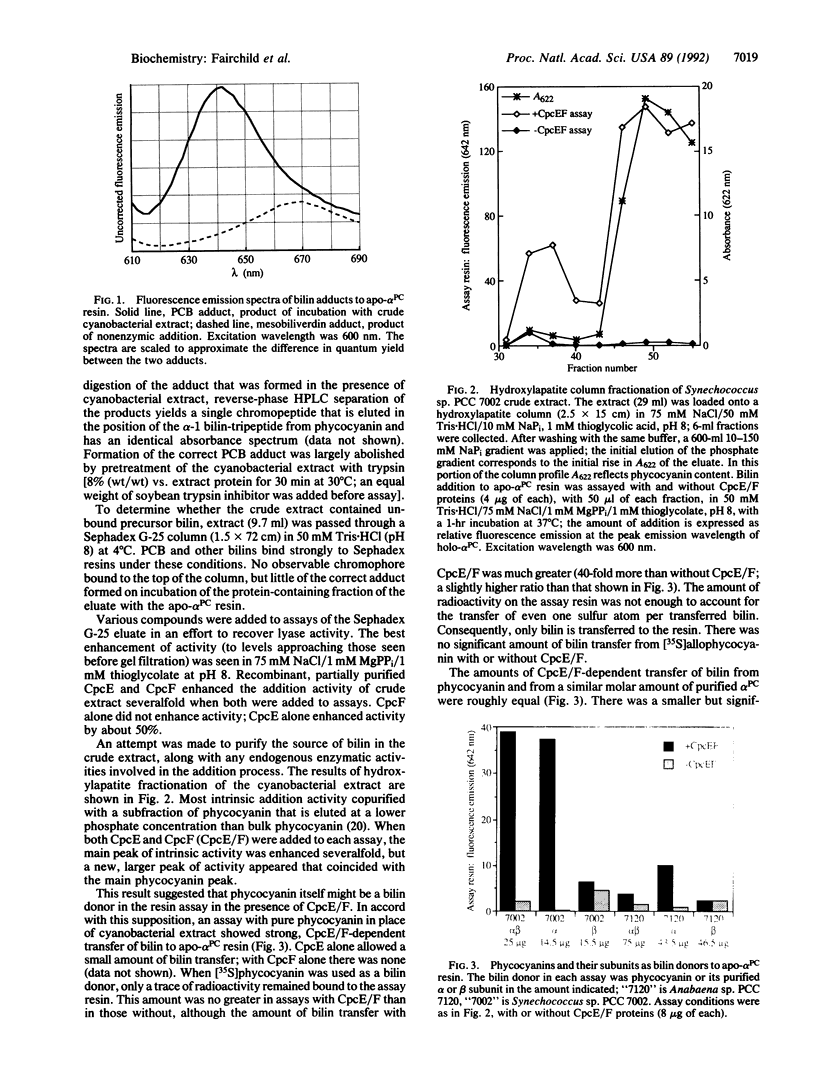
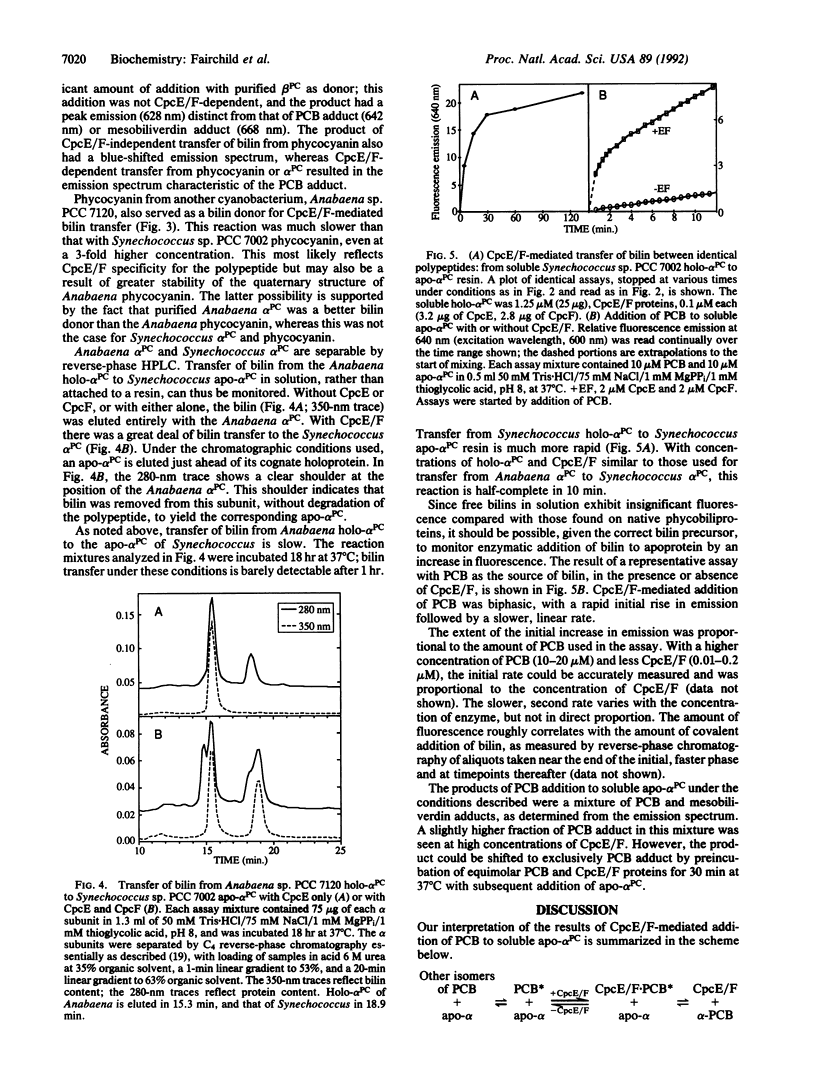
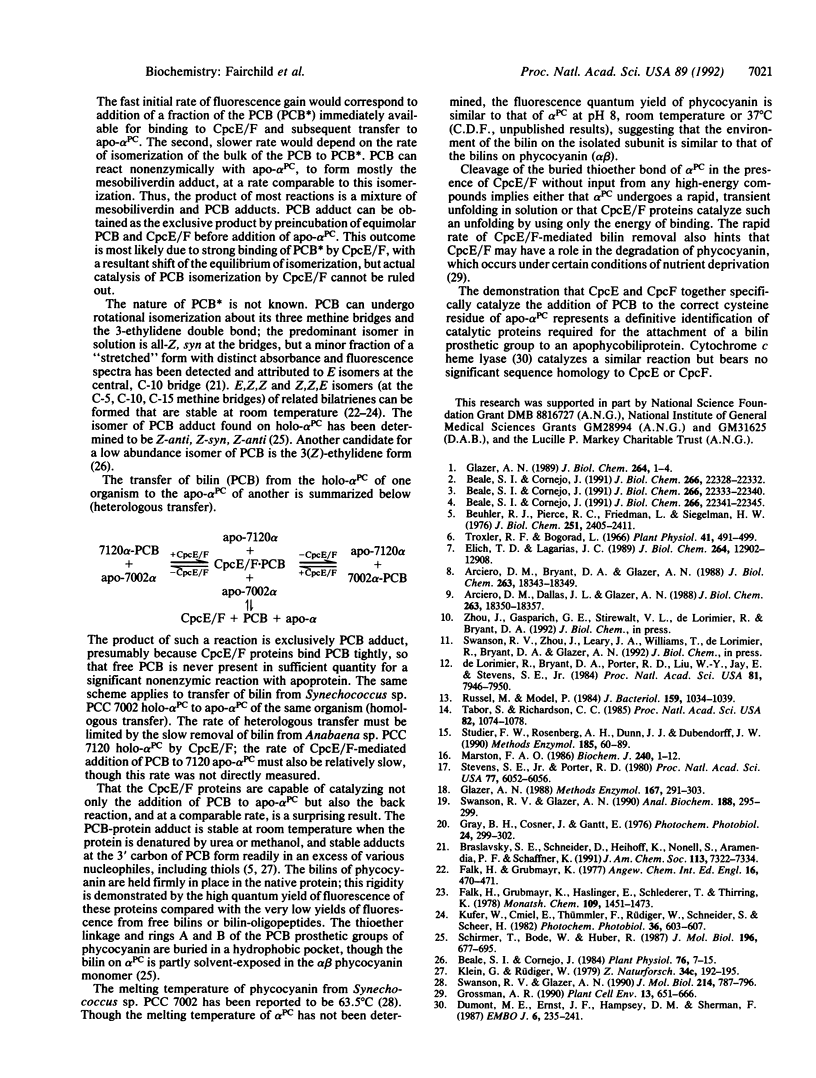
Images in this article
Selected References
These references are in PubMed. This may not be the complete list of references from this article.
- Arciero D. M., Bryant D. A., Glazer A. N. In vitro attachment of bilins to apophycocyanin. I. Specific covalent adduct formation at cysteinyl residues involved in phycocyanobilin binding in C-phycocyanin. J Biol Chem. 1988 Dec 5;263(34):18343–18349. [PubMed] [Google Scholar]
- Arciero D. M., Dallas J. L., Glazer A. N. In vitro attachment of bilins to apophycocyanin. II. Determination of the structures of tryptic bilin peptides derived from the phycocyanobilin adduct. J Biol Chem. 1988 Dec 5;263(34):18350–18357. [PubMed] [Google Scholar]
- Beale S. I., Cornejo J. Biosynthesis of phycobilins. 15,16-Dihydrobiliverdin IX alpha is a partially reduced intermediate in the formation of phycobilins from biliverdin IX alpha. J Biol Chem. 1991 Nov 25;266(33):22341–22345. [PubMed] [Google Scholar]
- Beale S. I., Cornejo J. Biosynthesis of phycobilins. 3(Z)-phycoerythrobilin and 3(Z)-phycocyanobilin are intermediates in the formation of 3(E)-phycocyanobilin from biliverdin IX alpha. J Biol Chem. 1991 Nov 25;266(33):22333–22340. [PubMed] [Google Scholar]
- Beale S. I., Cornejo J. Biosynthesis of phycobilins. Ferredoxin-mediated reduction of biliverdin catalyzed by extracts of Cyanidium caldarium. J Biol Chem. 1991 Nov 25;266(33):22328–22332. [PubMed] [Google Scholar]
- Beale S. I., Cornejo J. Enzymic Transformation of Biliverdin to Phycocyanobilin by Extracts of the Unicellular Red Alga Cyanidium caldarium. Plant Physiol. 1984 Sep;76(1):7–15. doi: 10.1104/pp.76.1.7. [DOI] [PMC free article] [PubMed] [Google Scholar]
- Beuhler R. J., Pierce R. C., Friedman L., Siegelman H. W. Cleavage of phycocyanobilin from C-phycocyanin. Separation and mass spectral identification of the products. J Biol Chem. 1976 Apr 25;251(8):2405–2411. [PubMed] [Google Scholar]
- Dumont M. E., Ernst J. F., Hampsey D. M., Sherman F. Identification and sequence of the gene encoding cytochrome c heme lyase in the yeast Saccharomyces cerevisiae. EMBO J. 1987 Jan;6(1):235–241. doi: 10.1002/j.1460-2075.1987.tb04744.x. [DOI] [PMC free article] [PubMed] [Google Scholar]
- Elich T. D., Lagarias J. C. Formation of a photoreversible phycocyanobilin-apophytochrome adduct in vitro. J Biol Chem. 1989 Aug 5;264(22):12902–12908. [PubMed] [Google Scholar]
- Glazer A. N. Light guides. Directional energy transfer in a photosynthetic antenna. J Biol Chem. 1989 Jan 5;264(1):1–4. [PubMed] [Google Scholar]
- Glazer A. N. Phycobiliproteins. Methods Enzymol. 1988;167:291–303. doi: 10.1016/0076-6879(88)67034-0. [DOI] [PubMed] [Google Scholar]
- Marston F. A. The purification of eukaryotic polypeptides synthesized in Escherichia coli. Biochem J. 1986 Nov 15;240(1):1–12. doi: 10.1042/bj2400001. [DOI] [PMC free article] [PubMed] [Google Scholar]
- Russel M., Model P. Replacement of the fip gene of Escherichia coli by an inactive gene cloned on a plasmid. J Bacteriol. 1984 Sep;159(3):1034–1039. doi: 10.1128/jb.159.3.1034-1039.1984. [DOI] [PMC free article] [PubMed] [Google Scholar]
- Schirmer T., Bode W., Huber R. Refined three-dimensional structures of two cyanobacterial C-phycocyanins at 2.1 and 2.5 A resolution. A common principle of phycobilin-protein interaction. J Mol Biol. 1987 Aug 5;196(3):677–695. doi: 10.1016/0022-2836(87)90040-4. [DOI] [PubMed] [Google Scholar]
- Stevens S. E., Porter R. D. Transformation in Agmenellum quadruplicatum. Proc Natl Acad Sci U S A. 1980 Oct;77(10):6052–6056. doi: 10.1073/pnas.77.10.6052. [DOI] [PMC free article] [PubMed] [Google Scholar]
- Studier F. W., Rosenberg A. H., Dunn J. J., Dubendorff J. W. Use of T7 RNA polymerase to direct expression of cloned genes. Methods Enzymol. 1990;185:60–89. doi: 10.1016/0076-6879(90)85008-c. [DOI] [PubMed] [Google Scholar]
- Swanson R. V., Glazer A. N. Phycobiliprotein methylation. Effect of the gamma-N-methylasparagine residue on energy transfer in phycocyanin and the phycobilisome. J Mol Biol. 1990 Aug 5;214(3):787–796. doi: 10.1016/0022-2836(90)90293-u. [DOI] [PubMed] [Google Scholar]
- Swanson R. V., Glazer A. N. Separation of phycobiliprotein subunits by reverse-phase high-pressure liquid chromatography. Anal Biochem. 1990 Aug 1;188(2):295–299. doi: 10.1016/0003-2697(90)90609-d. [DOI] [PubMed] [Google Scholar]
- Tabor S., Richardson C. C. A bacteriophage T7 RNA polymerase/promoter system for controlled exclusive expression of specific genes. Proc Natl Acad Sci U S A. 1985 Feb;82(4):1074–1078. doi: 10.1073/pnas.82.4.1074. [DOI] [PMC free article] [PubMed] [Google Scholar]
- Troxler R. F., Bogorad L. Studies on the formation of phycocyanin, porphyrins, and a blue phycobilin by wild-type and mutant strains of Cyanidium caldarium. Plant Physiol. 1966 Mar;41(3):491–499. doi: 10.1104/pp.41.3.491. [DOI] [PMC free article] [PubMed] [Google Scholar]
- de Lorimier R., Bryant D. A., Porter R. D., Liu W. Y., Jay E., Stevens S. E., Jr Genes for the alpha and beta subunits of phycocyanin. Proc Natl Acad Sci U S A. 1984 Dec;81(24):7946–7950. doi: 10.1073/pnas.81.24.7946. [DOI] [PMC free article] [PubMed] [Google Scholar]



